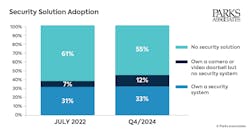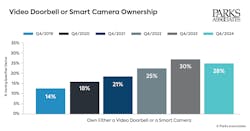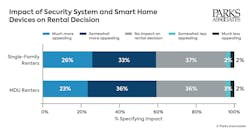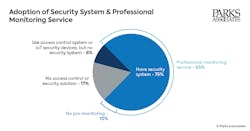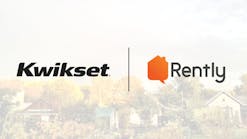Security adoption rates are steadily rising across multiple sectors – from single-family homes to multi-family residences, build-to-rent (BTR) communities, senior living spaces, and small-to-medium businesses (SMBs). As consumers and property managers demand integrated solutions that combine video surveillance, access control, cybersecurity, and emergency response, the market is shifting toward subscription-based services and professionally managed platforms.
Let's take a deeper dive into key market trends, adoption patterns, and emerging opportunities across the hottest residential and commercial sectors.
Growth in Residential Security Solutions
Parks Associates research finds that 45% of U.S. internet households own a security solution, and 32% subscribe to a security service. The use of security systems remains consistent, while some security devices – smart cameras and video doorbells specifically – have expanded the market for security solutions, with adoption rates doubling in the past five years to about 20% of households.
Artificial intelligence is also a more common tool, enabling user-friendly experiences through edge and cloud processing, generative content, and agentic features such as chatbots. Parks Associates data shows that 26% of home security system owners or intenders desire video analytics to identify specific events, such as distinguishing between people, packages, or cars.
Additionally, managed security services provide homeowners with a hands-off approach, where providers handle system maintenance, monitoring, and response coordination. These advancements strengthen the value proposition for consumers, making security solutions more proactive, reliable, and integrated with the broader smart home ecosystem.
Whether owners or renters, 77% of all security system owners pay for a service attached to their security system – the majority of which is professional monitoring.
Demand for smart home devices or features is the top-rated trigger for purchasing a security system, surpassing nearby crime, insurance discounts, and lifestyle factors like starting a family or traveling more. That demand is getting stronger, with 38% of security system owners who purchased their system in the past two years wanting smart home features, compared with just 22% of those whose systems are five years old or more.
Video devices are most in demand. Almost two-thirds of security system owners report acquiring a video doorbell or camera as part of their initial system purchase, and they are the devices most commonly added on later. Smart lighting and locks are also hot opportunities for aftermarket sales, with 8% adding each device type sometime after the initial sale.
These aftermarket device sales are a strong opportunity for additional revenue from existing customers. About a third of system owners add devices after the initial purchase regardless of how the system was initially obtained and installed.
Key Market Segments
Build-to-Rent Communities: Many consumers are renting single-family homes rather than purchasing. According to a new Parks Associates study, Single-Family Renters: Connectivity & Smart Home, this trend creates a unique and expanding market for build-to-rent (BTR) developers, internet service providers, residential security companies, and smart home solution providers.
The research revealed that roughly 60% of single-family renters find having security systems and smart home devices pre-installed makes a home more appealing to renters. As BTR communities continue to expand, the demand for integrated security solutions grows, with renters expecting modern amenities that enhance safety and convenience.
Smart home products and security systems can help attract and retain residents. Developer-led security integrations, such as smart locks, access control, and surveillance systems, provide additional value by streamlining tenant access, improving property management efficiency, and reducing security risks. They also differentiate communities in an increasingly competitive rental market.
Three-quarters of single-family renters report strong interest in at least one tested smart home product, with security systems and video doorbells the most desired.
Single-Family Rentals: Single-family renters often seek similar conveniences and connected amenities found in multi-family apartment complexes, while property owners and managers need solutions to easily turn over properties, keep energy costs low when vacant, and enable self-serve viewing for prospective tenants.
Ring and Amazon have played a key role in expanding video doorbell and smart security adoption in this sector.
Multi-family Housing: Safety and security are of great interest to residents and prospective multi-family residents, with a recent Parks Associates study rating the importance of security systems at the same level as a fitness center or gigabit internet speeds.
As a result, property managers are increasingly prioritizing security upgrades, recognizing that robust access control systems can be a key differentiator.
Deploying security solutions at scale requires a balance between advanced technology, cost management, cybersecurity, and operational efficiency. Multi-family properties must also address integration and retrofitting challenges, ensuring that new security systems are compatible with existing infrastructure while minimizing disruptions to residents.
The rise of “as-a-service” models also presents a major opportunity for security providers to offer ongoing management and monitoring, shifting security from a one-time investment to a long-term service-based revenue stream.
Senior Living and Assisted Care: According to the National Center for Assisted Living, there are nearly 31,000 residential care and assisted living communities in the United States, and demand for security solutions in these facilities is on the rise as new technologies continue to bridge the gap between security and healthcare.
Facilities are prioritizing resident safety by integrating fall detection, emergency response systems, and remote monitoring tools to enable faster response times and reduce injury risks. The intersection of security and connected health solutions is further helping to reshape senior care, with remote patient monitoring allowing for continuous tracking of vital signs and early detection of health concerns.
Small & Medium Businesses: SMBs rely on connected security solutions to protect their businesses, with concerns about staff safety, theft, and vandalism. Parks Associates research shows the vast majority of SMBs use an access control or alarm system, and most have professional monitoring. Some businesses opt for fully integrated security systems, while 8% rely on stand-alone devices like smart locks, cameras, or video doorbells. Cybersecurity is also a major concern, with 57% of SMBs subscribing to a cybersecurity or antivirus service and 82% taking steps to reduce cyber threats, such as installing security software (44%).
More SMBs are also turning to cloud-based and AI-powered security solutions to improve protection while keeping costs down. These advanced tools are helping SMBs to strengthen security without the high costs of traditional systems, making modern solutions more affordable and practical.
Future Outlook
Consumers have more choice than ever in security solutions and are watching their spending. This puts pressure on security providers to delight their customers and meet growing expectations around technology experiences.
As AI technology continues to play a crucial role in home security, it will enable more sophisticated security applications and services, providing greater peace of mind for homeowners.
Partnerships between security providers and ISPs will also become more integral to growth in smart home adoption, allowing consumers to bundle internet and security services for a seamless connected experience.
With tiered pricing and value-added services, security providers can maintain customers and increase recurring in the increasingly competitive smart home and security space while embracing the many opportunities to expand markets and technology portfolios.
